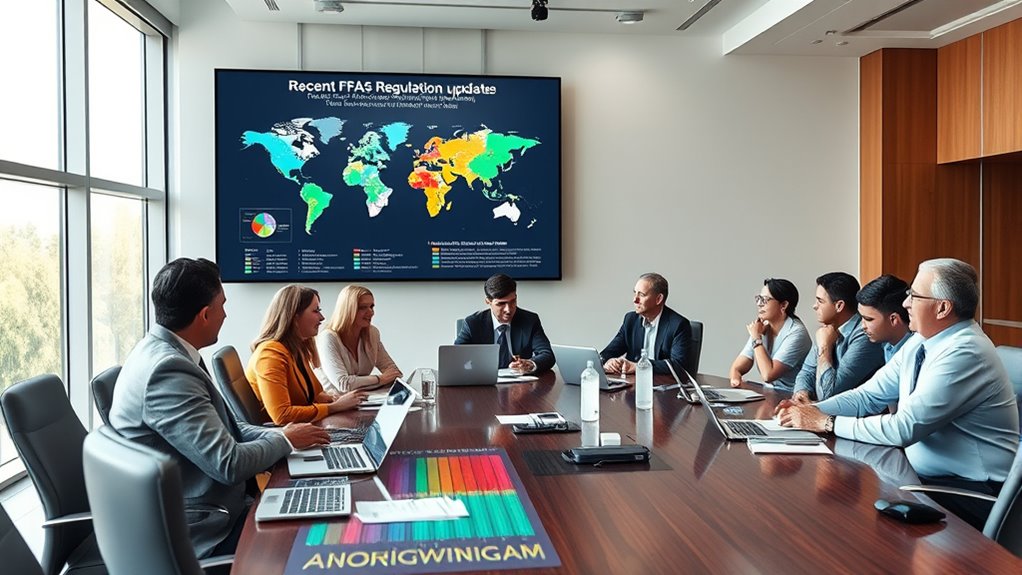Recent PFAS regulation updates are increasing scrutiny across industries, affecting everything from manufacturing to real estate. Stricter standards mean more testing, costly upgrades, and potential liabilities, which can delay projects and lower property values. Staying compliant requires proactive management of reporting, supply chains, and product design. By understanding these evolving regulations, you can identify new market opportunities and mitigate risks. Continuing to explore these trends will help you better navigate the complex landscape ahead.
Key Takeaways
- EPA’s addition of nine PFAS to the TRI list in 2025 increases mandatory reporting and compliance requirements for businesses.
- Stricter regulations, including bans on PFAS in biosolids and wastewater sludge, drive operational changes and remediation costs.
- Enhanced regulatory scrutiny heightens legal liabilities, leading to potential fines, lawsuits, and market value declines for contaminated properties.
- Companies must invest in PFAS mitigation, product redesign, and supply chain management to meet evolving standards and reduce liabilities.
- Staying ahead of regulatory updates offers strategic opportunities for innovation, market differentiation, and strengthening stakeholder trust.
Recent Regulatory Developments and Global Trends

Have you noticed how regulatory efforts around PFAS are evolving both across the U.S. and internationally? In the U.S., the EPA added nine PFAS to the TRI list in 2025, raising the total reportable chemicals to 205, with reports due by July 1, 2026.
Regulatory efforts around PFAS are expanding nationwide and internationally, with new rules and stricter standards emerging globally.
A significant new use rule for inactive PFAS was finalized early 2024, blocking manufacturing or processing without EPA review. Additionally, starting October 1, 2024, the use of PFAS in biosolids and wastewater sludge as soil amendments is prohibited, aligning with the emphasis on natural materials in environmentally conscious regulations.
States are enacting their own rules, including stricter drinking water standards and bans on certain PFAS applications.
Globally, countries like those in the EU are implementing strict regulations, banning PFAS in products and establishing environmental limits, with international cooperation increasing.
Moreover, the ongoing regulatory landscape reflects growing awareness of the environmental and health impacts associated with PFAS.
Impact on Commercial Real Estate Market Dynamics

Recent regulatory developments around PFAS are reshaping the commercial real estate landscape by increasing the complexity of environmental due diligence. You now need to include PFAS screening as part of Phase I ESAs due to EPA’s hazard designation, which lengthens transaction timelines and raises costs.
When contamination is suspected, specialized soil and groundwater testing during Phase II assessments become necessary, adding complexity and expense. This heightened scrutiny leads lenders, insurers, and buyers to adopt more cautious risk assessments, often delaying deals or reducing interest. Incorporating comprehensive testing methods can help identify issues early and mitigate potential liabilities, especially considering the essential oils for contaminant detection that enhance testing accuracy.
Property values decline as contamination fears and remediation costs grow, creating market stigma. Developers and investors face increased hurdles, including stricter land use requirements and potential liabilities, which dampen market demand and lead to lower prices and extended sale processes. Additionally, the evolving regulatory landscape emphasizes the importance of risk management strategies to navigate these challenges effectively.
Challenges for Business Operations and Product Development

Managing the evolving PFAS regulations presents significant operational challenges for businesses, requiring substantial investments in equipment upgrades to reduce or eliminate PFAS from manufacturing processes. You’ll need to allocate capital for new equipment and adapt existing systems, which can increase production costs and impact operational efficiency. Additionally, staying informed about the latest regulatory updates is crucial for maintaining compliance and avoiding penalties.
Staying compliant involves detailed reporting, permit applications, and managing complex regulatory frameworks, adding administrative burdens. Product redesign may be necessary to meet market access standards, requiring innovation while maintaining quality and consumer appeal. This often involves research and development to identify effective substitutes that meet safety and performance standards. Incorporating innovative alternative materials can help meet these standards and reduce environmental impact.
You’ll face technical hurdles in substituting PFAS with effective alternatives and bear the costs of testing and redesign. Managing supply chain disruptions and ensuring safety and environmental compliance further complicate operations, demanding strategic planning and resource allocation to navigate these evolving challenges effectively. Payment processing solutions can assist by streamlining compliance reporting and facilitating efficient transaction management as part of overall operational adaptation.
Legal and Liability Risks for Various Industries

As PFAS regulations continue to expand, industries face rising legal and liability risks that can substantially impact their operations. Increasing federal oversight heightens exposure to claims related to contaminated water and property damage.
Recent litigation trends show a surge in PFAS-related lawsuits, including bodily injury and property damage cases. Businesses in manufacturing, real estate, and municipalities are especially vulnerable due to contamination and regulatory actions.
Liability extends to historic pollution and sudden spills, complicating insurance coverage and liability assessments. Manufacturers face product liability risks if their products contain PFAS for water- or fireproofing.
Supply chain companies can also be held liable, even if they don’t directly use PFAS. To manage these risks, firms are adopting extensive insurance strategies and ensuring regulatory compliance. Incorporating color accuracy and contrast ratio considerations from home cinema technologies can help in assessing environmental impacts and improving detection methods related to PFAS contamination.
Furthermore, understanding the long-term health effects of PFAS exposure is crucial for accurately evaluating potential liabilities and implementing preventative measures.
Investor Expectations and Stakeholder Engagement

Investors now expect companies to demonstrate strong compliance with evolving PFAS regulations by implementing effective risk management strategies. They want transparent reporting on PFAS use, risks, and phase-out plans, showing proactive steps to address potential liabilities and reputational impacts.
Engaging with stakeholders is vital; investors look for companies that actively communicate with communities, NGOs, and regulators to foster trust and ensure alignment with public concerns.
Developing alternatives to PFAS not only mitigates risks but also positions your business to capitalize on emerging market opportunities.
Additionally, investors are monitoring how well you incorporate PFAS considerations into your overall ESG strategy, including supply chain transparency and advocacy efforts.
Meeting these expectations demonstrates your commitment to responsible practices and enhances investor confidence amid regulatory shifts.
Strategic Responses and Emerging Opportunities

To effectively respond to the evolving PFAS regulatory landscape, companies are adopting strategic compliance measures that align with new federal and state requirements. You’re implementing advanced chemical inventory tracking to meet EPA reporting obligations for added PFAS substances in the TRI.
Internal notification protocols ensure EPA review before manufacturing or processing any of the 329 PFAS under SNUR. Continuous monitoring systems are being established to track state-specific bans, such as those on PFAS in biosolids or wastewater sludge used as soil amendments.
Your supply chain verification processes confirm compliance and prevent unauthorized PFAS use. Additionally, you’re developing rapid response frameworks to adapt to upcoming EPA and legislative updates.
These strategies position you to mitigate risks, manage liabilities, and capitalize on emerging opportunities in the shifting PFAS regulatory environment.
Frequently Asked Questions
How Can Small Businesses Effectively Manage PFAS Compliance Costs?
To manage PFAS compliance costs effectively, you should familiarize yourself with reporting requirements and stay updated on regulatory changes.
Substantiate your CBI claims and keep detailed records to streamline audits.
Register on the Central Data Exchange and consider consulting legal or environmental experts for guidance.
Collaborate with industry peers to share strategies and advocate for regulations that ease your burden.
Budget wisely and support legislation aimed at reducing your financial impact.
What Are the Best Practices for PFAS Risk Disclosure in Real Estate Transactions?
Did you know that over 80% of property transactions now include PFAS disclosure? You should clearly identify PFAS as a contaminant in purchase agreements, ensuring transparency.
Conduct thorough Phase I and II ESAs to detect any contamination.
Use detailed risk allocation clauses and indemnities to protect yourself.
Staying upfront about PFAS risks helps manage legal liabilities, supports negotiations, and preserves your property’s market value.
How Do PFAS Regulations Vary Between Different Countries and Regions?
You’ll find that PFAS regulations differ markedly across regions. The EU has a strict, centralized approach with phased implementation, focusing on drinking water and industrial emissions.
In the US, regulations are more fragmented, with some states imposing immediate bans and others adopting gradual measures.
Asia-Pacific countries are still developing their policies, mainly targeting water contamination and industrial discharge, leading to varied standards and enforcement timelines.
What Technological Innovations Are Emerging to Detect and Remediate PFAS Contamination?
You should know about emerging technologies that make detecting and remediating PFAS easier and faster. Portable nanosensing and paper spray mass spectrometry provide quick, sensitive detection even at tiny levels.
Real-time sensors and geospatial platforms help track contamination in real time and map vulnerable areas. Innovative remediation tools, like PFAS screening sensors and destructive technologies, reduce costs and environmental persistence, making it easier to protect public health and address contamination effectively.
How Might Future PFAS Regulation Changes Impact Existing Product Portfolios?
About 70% of companies report that future PFAS regulation changes will require significant product reformulation. You’ll need to carefully assess your current portfolio, as new rules may restrict or ban certain PFAS substances.
This could lead to costly reformulations, supply chain disruptions, and compliance challenges. Staying ahead of evolving regulations helps you avoid penalties, maintain market access, and even discover opportunities for PFAS-free innovation.
Conclusion
Staying ahead of PFA S regulations is like steering a shifting tide—you must adapt quickly or risk being left behind. These rules are the compass guiding your business through turbulent waters, revealing both pitfalls and new horizons. Embrace the change as an opportunity to innovate and strengthen your position. By proactively responding, you turn regulatory storms into stepping stones, ensuring your journey remains steady and your destination, success.








